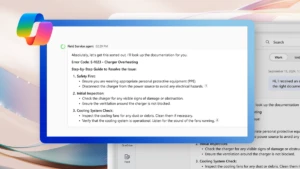
Fast track development with AI and low-code
AI is driving unprecedented opportunities for businesses. With advancements in AI and low-code development platforms, organizations are finding new ways to accelerate their growth and efficiency.
And it couldn’t come at a better time, because technology has a talent problem. There’s just not enough high-tech talent in the pipeline to help organizations develop and maintain the complex software solutions they need to stay competitive.1

Microsoft Power Platform
Embrace the benefits of AI and low-code with Microsoft Power Platform.
And the work is indeed complex. Developers need to solve challenges around user interface design, storage requirements, security, compliance, and scalability in their work, and finding the right talent to meet challenges is difficult.
The problem is compounded with the amount of work that needs to get done. Chief Information Officers (CIOs) and Chief Technology Officers (CTOs) have to manage growing app backlogs and pushed-back schedules for the development of the apps they know they need, and a general lack of resources for talent and software makes the outlook for new custom apps unclear.
With more development work to be done than there are developers to do it, many CIOs and CTOs are looking to AI and low-code solutions to transform their application development approach and strategy.
AI and low-code are helping in three ways:
- Increasing developer productivity
- Automating repetitive tasks
- Boosting the skills and abilities of non-developers who can now make meaningful contributions to development
Let’s look at those benefits in detail.
Increasing developer productivity while remaining compliant and secure
The first thing that low-code can do for a team of developers is enable it to work more quickly with no tradeoff in attention to compliance and security.
As described in a recent white paper on generative AI disruption in software from McKinsey, putting AI and low-code into the hands of developers can improve productivity by as much as 45%, something which can lower code development costs considerably.
At Microsoft, we’ve observed the effectiveness ourselves. In a review of the first 126,000 organizations using Microsoft Copilot in Microsoft Power Apps, developers say using Copilot makes them faster (80%) and more satisfied with their work (65%). What’s more, the developers using Copilot have a 60% higher success rate than the developers who don’t.
But it’s not all about speed. Low-code solutions don’t just accelerate development—they ensure support of standards for security and compliance, so all the newfound speed doesn’t compromise safety. And low-code makes developers into better developers, too. It amplifies existing talent and experience to help developers identify roadblocks, find solutions, and dream up new innovations.
Visit the Microsoft Power Platform website to learn more.
Automating repetitive coding tasks
AI-powered development tools excel at automating repetitive and time-consuming tasks that drain the fun out of development work. A routine chore like debugging code can make a developer do the same find-and-fix tasks repeatedly. And development work is filled with necessary but repetitive tasks.
With AI and low-code, writing boilerplate code, debugging, conducting routine software maintenance, performing code reviews, and managing deployments can be done by an AI assistant, allowing the developer to work on the interesting, creative challenges that drive business impact.
We’ve seen this ourselves at Microsoft. In a recent survey—quantifying GitHub Copilot’s impact on developer productivity and happiness—96% of respondents say AI increases their speed with repetitive tasks. They also say using AI makes them happier. Between 60% and75% of surveyed users said using the tool makes them feel less frustrated when coding and free to focus on more satisfying work.
Boosting the skills and abilities of non-developers
With AI and low-code, organizations can bring non-developers into the development process so they can help create apps and innovate alongside their developer colleagues. Democratizing development enhances an organization’s agility and flexibility.
Business users won’t need extensive coding expertise because AI and low-code let them contribute through natural language inputs, like “create a sales report dashboard” or “automate customer follow-up emails”. Additionally, business users can learn to build their applications faster than ever with the ability to query in-product assistants that can help them build in real time.
By equipping citizen developers with intuitive, low-code tools, they can autonomously create applications that address immediate business needs, such as a mobile app for onsite invoice submissions. This not only reduces the burden of manual tasks but also ensures more accurate data collection and enhances the efficiency of frontline workers. Meanwhile, professional developers can dedicate their expertise to more complex, strategic projects that propel the organization forward. This symbiotic relationship between low-code and traditional development practices fosters an environment where technical agility and innovation thrive, ultimately propelling the organization’s technical velocity to new heights.
When the AI and low-code development tools that an organization uses allow for simplified cross-platform integration as Microsoft Power Platform does, they can break down barriers and ensure business users receive the right oversight and collaborative inputs from colleagues’ developer and IT teams.
Next steps for CIOs and CTOs
If you want to fully embrace the benefits of AI and low-code by incorporating a solution into your tech stack at scale, consider a strategic plan that addresses the following:
- Identify high-impact use cases to begin testing. Determine what type of solutions would benefit your organization most: Do you need web or mobile apps for employees or customers? A website with customizable content management, styling, and data access requirements? Or perhaps custom AI agents that handle specific tasks? Once you’ve identified the best pilot project, implement the solution to deliver quick wins and demonstrate the value of AI and low-code. Document successes and share them to build momentum within your organization.
- Manage risks by ensuring data security and regulatory compliance. It’s important to choose an enterprise solution like Microsoft Power Platform that includes governance, management, and monitoring capabilities. With your solution in place, you can then establish a governance framework to maintain control, such as setting up regular review meetings to ensure compliance and having your IT department or risk management team conduct periodic risk assessments.
- Build a low-code center of excellence. With governance in place and some development wins under your belt, think about upskilling your workforce. Offer tailored programs to upskill both developers and non-developers, promoting continuous learning and cross-functional collaboration, such as hosting workshops and interactive training sessions, where your low-code users and developers can work together. The Microsoft Power Platform Adoption website has workbooks, best practices, and training materials to support organizations with this endeavor.
By following these steps, you can effectively integrate AI and low-code solutions like Microsoft Power Platform, bridging the development gap and driving innovation in your organization.
Visit the Microsoft Power Platform website to learn more.
Microsoft Power Platform Virtual Training Day
Join us at a Microsoft Power Platform Virtual Training Day to drive innovation, support development, and rapidly respond to evolving business challenges. Register for free, in-depth training events, where you’ll discover how Power Platform tools can empower your employees to build custom apps, automate workflows, and analyze data, regardless of technical expertise.
Source:
1 Forbes, Research: quantifying GitHub Copilot’s impact on developer productivity and happiness, March 6, 2023




